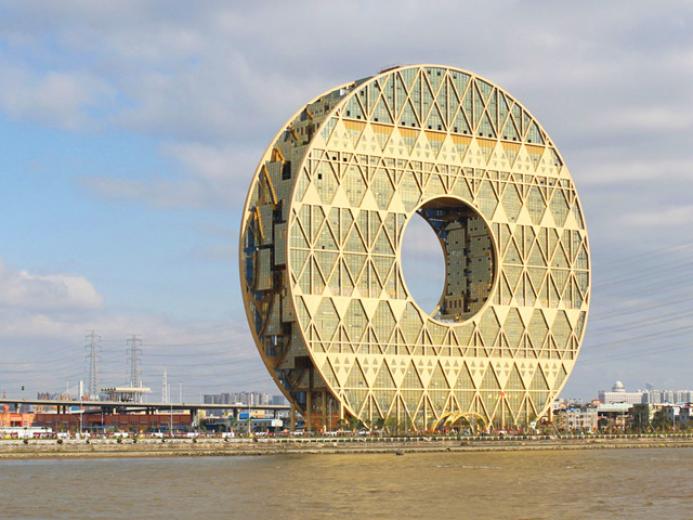1 13
1 13
ADVERTISEMENT
14. Guangzhou Circle Buildingt, China
(AKA "the Golden Doughnut")
452.7 ft. tall
33 stories
278,871 sq. ft.
Completed: 2013
Architect: Joseph di Pasquale
Developer: Hongda Xingye Group
Features: Elevated gardens within the central void. Designed according to Feng Shui concepts corresponding to the number 8 and infinity symbol. Built in the Baiyun District, an eco-friendly business area.
13. The Gherkin, London
(AKA 30 St. Mary Axe, London)
591 ft. tall
41 stories
6,561 sq. ft.
Architect: Norman Foster
Developer: Swiss Re
Completed: 2004
Features: Natural daylight and ventilation. Testing innovative vegetated facade panel or "green wall" known as a "core hydraulic integrated arboury panel." Expected to use less than half the energy consumed by air-conditioned office towers.
12. Hearst Tower, New York City
597 ft. tall
46 stories
860,000 sq. ft.
Architect: Norman Foster
Developer: Hearst Corp.
Features: Atrium is paved with heat conductive limestone over tubing with circulating water for cooling and heating. Rain collected on roof is stored in basement tank for cooling system. 85% of structural steel contains recycled material. New York City's first LEED-Gold skyscraper.
Completed: first six stories in 1928; additional tower in 2006
11. 340 on Park, Chicago
672 ft. tall
62 stories
770,000 sq. ft.
Completed 2007
Architect: Solomon Cordwell Buenz
Developer: Magellan Development
Features: Chicago's tallest all-residential tower. First Midwestern tower to achieve LEED Silver.
10. Heron Tower, London
(AKA Salesforce Tower London)
755 ft. tall
46 stories
133,976 sq. ft.
Architect: Kohn Pedersen Fox
Developer: Heron International
Completed 2011
Features: 18,492-gallon aquarium in atrium stocked with 1,200 tropical fish of 67 species. Triple-skin glazed facade with photovoltaic cells to generate electricity and act as solar shield, reducing heat absorption. Natural daylight.Internal air handling plant rooms for heat recovery and ice storage facility and adiabatic cooling to reduce energy consumption. BREEAM rating: Excellent.
9. Eureka Tower, Melbourne, Australia
975 ft. tall
92 stories
576 apartments
1.3 million sq. ft.
Architect: Fender Katsalidis Architects
Developer: Daniel Grollo/Grocon Construction, Tab Fried
Completed 2006
Features: Eureka Skydeck 88 observation deck on 88th floor is highest public vantage point in a building in the Southern Hemisphere. "The Edge," a glass cube, moves out over the edge of the building. Top 10 floors have 24-carat gold plated glass windows. Low-emission, natural materials used throughout. Facade is made of minimum amounts of aluminum and glass thickness. Double-glazed windows reduces the need for heating and air-conditioning systems.
8. The Shard, London Bridge
1,012 ft. tall
87 stories
589,602 sq. ft.
Architect: Renzo Piano
Developer: Sellar Property Group, Qatar
Completed 2013
Features: Sophisticated glazing system reflects sunlight and sky so the building changes with the seasons and is energy efficient. Combined heat and power plant contained within, operating on natural gas from the British National Grid; fuel is efficiently converted to electricity and heat is recovered from the engine to provide hot water for the building.
7. Pearl River Tower, Guangdong, China
(AKA Guangdong Tobacco Building)
1,016 ft. tall
71 stories
2.3 million sq. ft.
Architect: Skidmore, Owings & Merrill with Adrian D. Smith and Gordon Gill
Developer: China National Tobacco Corp.
Completed: 2011
Features: Clean tech skyscraper. Most energy-efficient super-tall building in the world with largest radiant cooling system, wind turbines and solar collectors. Designed to minimise hard to the environment and to extract energy from natural and passive sources surrounding it.
6. China World Trade Center Tower 3, Beijing
China World Trade Center 3
Beijing, China
1,083 ft. tall
74 stories
280,000 sq. ft.
Architect: Skidmore, Owings & Merrill
Developer: China World Trade Center
Completed: 2010
Features: LEED Gold Core & Shell certified. Energy efficient LED lighting on exterior and crystalline facade covered in fritted glass and metal fins that act as vertical sunshades, maximizing interior daylighting. Rooftop features pine garden; building also includes grand ballroom, retail podium and landscaped water garden. Billed as "the Place Where China Meets the World."
4. International Commerce Center, Hong Kong
1,588 ft. tall
118 stories
Architect: Kohn Pederson Fox Associates and Wong & Ouyang HK Ltd.
Developer: Sun Hung Kai Properties
Completed: 2010
Features: Certified Hong Kong Building Environmental Assessment Methods (HK BEAM) Platinum. LEED Gold certification. Includes sky100 Hong Kong Observation Deck and Ritz-Carlton Hotel as well as offices and retail. Hosts the largest light and sound show on a single building. Also features world's highest swimming pool.
3. Shanghai World Financial Center, China
1,614 ft. tall
101 floors
sq. ft.
Architect: Kohn Pedersen Fox
Developer: Morgan Stanley, Chinese, Japanese and Hong Kong banks
Completed: 2008
Features: LEED Gold pre-certified. Begun in 1997 before environmentalism became a building concern, yet its structural
design reduces the amount of structural material and thus embodied energy in the design overall.
2. Taipei 101, Taipei, Taiwan
1,667 ft. tall
101 floors
2.08 sq. ft.
Completed: 2004
Architect: C.Y. Lee & Partners
Developer: TFCC
Features: Taipei 101 was designed before the release of LEED and Taiwan’s own green building rating system (EEWH),but the project team later incorporated green features into the design. TFCC chose LEED for Existing Buildings: Operations & Maintenance certification. Taipei 101 is also in the top 30% of high-rise office buildings as benchmarked by the Energy Star database, reducing energy consumption by 33.41 million kWh per year and saving more than $2 million per year. Low-flow water fixtures and water management systems reduced water usage by at least 30% compared to average building consumption, saving about 28,000,000 liters of potable water annually.
1. One World Trade Center, New York City
1,776 ft. tall
104 stories
3 million sq. ft.
Architect: Skidmore Owings & Merrill
Developer: The Durst Organization, The Port Authority of New York and New Jersey
Features: LEED Gold Core & Shell certified. State-of-the-art life-safety systems. PureCell phosphoric acid fuel cells generate 4.8 MW of power. Materials used are 80% recycled. Uses off-site wind and hydroelectric power. Windows designed to allow maximum daylight to pass through.

